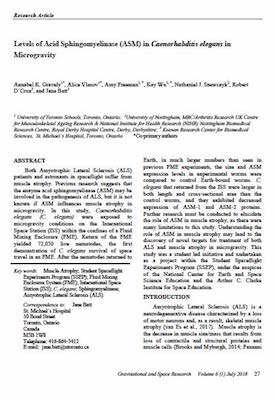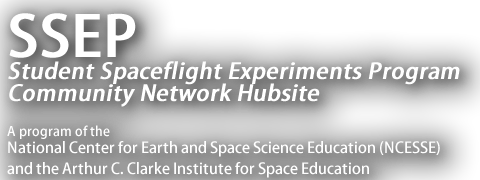This page provides a video archive of presentations at the annual SSEP National Conference by student researchers whose experiments were part of the SSEP Mission 8 to ISS Kitty Hawk experiments payload. Mission 8 to ISS was the tenth SSEP flight opportunity.
Kitty Hawk launched on SpaceX-9, 12:45 am ET, July 18, 2016, from Cape Canaveral Air Force Station, Florida. Kitty Hawk also returned to Earth on SpaceX-9, splashing down in the Pacific off the California coast, on August 26, 2016.
For details on the flight profile for Kitty Hawk, see the SSEP Mission 8 to the International Space Station (ISS) page.
Some student flight teams present at more than one annual conference, reporting out status at various stages of the life cycle of a flight experiment. It is also true that not all student flight teams attend a conference. For details on all Kitty Hawk flight experiments, see the Selected Experiments on SSEP Mission 8 to ISS page.
Calgary, Alberta, Canada
Title: Investigation of the Susceptibility of Escherichia coli to Ampicillin in Microgravity Compared to Earth Gravity Conditions
Oral Presentation, 7th Annual SSEP National Conference, June 2017
Bishop Carroll High School
Grade levels: 11-12
Type of Experiment: Flight Experiment, Mission 8
Co-Principal Investigators: Sophie Gobeil, Lauren St.Clair
Collaborators: Arlene Hufalar, Jonathan Breidfjord, Leila Lok, Michael Rozek, Jasmine Gordon
Teacher Facilitator: Amy Webster
Abstract: We investigated whether the susceptibility of Escherichia coli bacteria to ampicillin antibiotic is influenced by differing gravity conditions. Parallel E. coli populations were kept dormant in saline on Earth and in Space until D-5. At this point, a clamp was released to allow the populations to grow in nutrient broth until D-2, when they were exposed to ampicillin. There was no significant difference in the amount of E. coli that survived ampicillin exposure in microgravity compared to Earth gravity.
Toronto, Ontario, Canada – Ryerson University
Title: Will Microgravity Affect the Growth of Pleurotus ostreatus?
Oral Presentation, 5th Annual SSEP National Conference, July 2015
Ryerson University
Grade levels: 11 and 2nd year Undergraduate
Type of Experiment: Flight Experiment, Mission 8
Co-Principal Investigators: Komalpreet Kahlon, Francis Buguis, Gemma Mancuso, Modlin Orange, Kugenthini Tharmakulasekaram
Collaborator: Murad Jabarov
Teacher Facilitator: Bryan Koivisto, Nathan Battersby
Abstract: This experiment aims to explore the effect of microgravity on the growth of the saprotrophic fungus Pleurotus ostreatus, more commonly known as the pearl oyster mushroom. This fungus has been subject to much research. This highly nutritious fungus is grown in many countries and is consumed as a major source of nutrients. Differences in growth will be determined by studying the mycelial content in both samples. This research could be a step towards the production of food in space.
Toronto, Ontario, Canada – University of Toronto Schools
 Scholarly Publication
Scholarly Publication
Title: Levels of Acid Sphingomyelinase (ASM) in Caenorhabditis elegans in Microgravity
Journal of the American Society for Gravitational and Space Research, Volume 6, Issue 1, July 2018, Pages 27-36
Download Paper
Type of Experiment: Flight Experiment, Mission 8
Authors: Annabel K. Gravely (1), Alice Vlasov (1), Amy Freeman (1), Kay Wu (1), Nathaniel J. Szewczyk (2), Robert D’Cruz (3), Jane Batt (3)
Abstract: Both Amyotrophic Lateral Sclerosis (ALS) patients and astronauts in spaceflight suffer from muscle atrophy. Previous research suggests that the enzyme acid sphingomyelinase (ASM) may be involved in the pathogenesis of ALS, but it is not known if ASM influences muscle atrophy in microgravity. In this study, Caenorhabditis elegans (C. elegans) were exposed to microgravity conditions on the International Space Station (ISS) within the confines of a Fluid Mixing Enclosure (FME). Return of the FME yielded 72,050 live nematodes, the first demonstration of C. elegans survival of space travel in an FME. After the nematodes returned to Earth, in much larger numbers than seen in previous FME experiments, the size and ASM expression levels in experimental worms were compared to control Earth-bound worms. C. elegans that returned from the ISS were larger in both length and cross-sectional area than the control worms, and they exhibited decreased expression of ASM-1 and ASM-2 proteins. Further research must be conducted to elucidate the role of ASM in muscle atrophy, as there were many limitations to this study. Understanding the role of ASM in muscle atrophy may lead to the discovery of novel targets for treatment of both ALS and muscle atrophy in microgravity. This study was a student led initiative and undertaken as a project within the Student Spaceflight Experiments Program (SSEP), under the auspices of the National Center for Earth and Space Science Education and the Arthur C. Clarke Institute for Space Education.
1. University of Toronto Schools, Toronto, Ontario
2. University of Nottingham, MRC/Arthritis Research UK Centre for Musculoskeletal Ageing Research & National Institute for Health Research (NIHR) Nottingham Biomedical Research Centre, Royal Derby Hospital Centre, Derby, Derbyshire
3. Keenan Research Center for Biomedical Sciences, St. Michael’s Hospital, Toronto, Ontario
Title: How will Microgravity Affect the Functions and Development of Stem Cells in S. Mediterranea Flatworm?
Oral Presentation, 5th Annual SSEP National Conference, July 2015
Independent School
Grade levels: 8 and 11
Type of Experiment: Finalist Experiment, Mission 8
Co-Principal Investigators: Arjun Aggarwal, Rahim Dhalla, Matthew Egan, Madeline Elder, Alisia Lalji
Collaborators: Jeffrey Burrows, Ko Currie, Michael Prysciak
Teacher Facilitator: Suzanne Monir
Abstract: We devised a plan to examine the effects of placing a sexual and asexual species of Planarian flatworm, known as Schmidtea mediterranea, under microgravity. Planarians are capable of complete regeneration from any fragment of their body and have become essential in stem cell research. These organisms have unique genomic tools allowing for analysis of their regeneration process from a molecular perspective. Alteration of gravity can affect stem cell polarity, intercellular communication, and expression of related genes and processes essential to stem cell proliferation.
Santa Ana, California
Title: Investigation of Water Absorption
Oral Presentation, 5th Annual SSEP National Conference, July 2015
Mendez Fundamental, Santa Ana Unified
Grade level: 6
Type of Experiment: Flight Experiment, Mission 8
Co-Principal Investigators: Haydee Contreras, Sandy Ceja, Daniel Polanco, Anthony Montiel
Teacher Facilitator: Lizette Cabrera
Abstract: The purpose of the experiment is to observe the effect of microgravity on the water absorption of Hyaluronic Acid (Sodium Hyaluronate) to see whether the lack of gravity will have a positive, negative or neutral effect on the water absorption of Hyaluronic Acid. Water absorption and maintaining moisture are important in space because there is only a limited amount of water sources on the ISS and maintaining moisture levels in microgravity environments can help the astronauts’ daily lives.
Vista, California
Title: Microgravity’s Effect on Raphanus sativus Seed Germination
Oral Presentation, 7th Annual SSEP National Conference, June 2017
Vista Magnet Middle School
Grade level: 8
Type of Experiment: Flight Experiment, Mission 8
Co-Principal Investigators: Victoria Arseneault, Lexie Kondo, Karsyn Lee
Teacher Facilitator: Christine Bartee
Abstract: This experiment was designed to test the Raphanus Sativus seed germination in microgravity compared to the ground truth. 8 seeds in rockwool soil were activated in willow water and raw honey on A=0 in microgravity. The experiment was terminated at U-2 by a formaldehyde solution. The analysis included quantifying the number of seeds germinated. We concluded that seed germination is possible in microgravity and the number of seeds germinated in microgravity were similar to the ground truth.
Boise, Idaho
Title: Effect of Matrix Metalloproteinase-1 on Collagen Integrity in Microgravity
Oral Presentation, 7th Annual SSEP National Conference, June 2017
Treasure Valley Mathematics and Science Center
Grade level: 7
Type of Experiment: Flight Experiment, Mission 8
Co-Principal Investigators: Brynne Coulam, Catherine Ji
Teacher Facilitator: Dr. David Whitacre
Abstract: The enzyme Matrix Metalloproteinase-1 (MMP-1) underlies astronauts’ health detriments by lysing collagen. Collagen fibrils are less damaged by proteolysis when strained by physical force acting on fibril networks; we hypothesize absence of gravitational force renders a given MMP-1 amount more destructive. Phosphate-buffered Gelfoam® samples with and without MMP-1 constituted microgravity experiments; this, quadruplicated, constituted ground experiments. Electrophoresis indicated no difference between environments in cleavage of collagen’s primary structure. The Gelfoam® model was inconclusive regarding the hypothesised effect on fibrillar structure.
Prince George’s County, Maryland
Title: Hot Pepper Power
Oral Presentation, 6th Annual SSEP National Conference, June 2016
Chesapeake Math & Information Technology Elementary School
Grade level: 5
Type of Experiment: Flight Experiment, Mission 8
Co-Principal Investigators: Akintunji Akinselure, Pamela Ikegwu, Lise Chelsea Mbakop, Clarence Rucker, Victoria Rush, Ebrima Sise, Jasmine Wilson
Co-Investigators: Dariel Gray, Kayla Kingston, Darlene Opoku, Roshni Pawar, Cameron Salisbury, Sydney Virgil, London Wiggins
Collaborators: Joycelyn Ajiboye, Grace Akinsola, Caleb Bradley, Jailyn Buie, Zoe Burkett, Iris Daniels, Nandi Edwards, Ralph Martino, Bryant-Alexander Oliphant, Hannah Simmons
Teacher Facilitator: Benora McCain
Abstract: The students from Chesapeake Math & Information Technology Elementary School in Prince George’s County decided to research hot peppers. We researched and discovered that hot peppers can fight bacteria. The purpose of this mission is to find alternative food sources for astronauts. If they can germinate hot peppers this could be used to help fight bacteria. This will keep astronauts healthy. We hope hot pepper seeds will germinate in a microgravity environment. This could be a new food source for astronauts.
New York, New York – NEST+m
Title: The Effect of Microgravity on Bacterial Biofilm Formation on Soft Contact Lenses
Oral Presentation, 5th Annual SSEP National Conference, July 2015
New Explorations into Science Technology and Math, NYC Department of Education
Grade level: 5
Type of Experiment: Flight Experiment, Mission 8
Principal Investigator: Maya Karri
Collaborators: Alex Apelewicz, Chloe Coward, Tori Feinstein, Michelle Fridman, Jack Galligan, Anabel Giacobbi, Benjamin Goodstein, Quinci Huston, Andrew Kogan, Vivian Lee, Spring Lin, Haydn Long, Samantha Mayol, Ines Menendez, Fiona O’Reilly, Jean Carlos Paredes, Catherine Pyne, Kiara Reyes, Natalie Roston, Jacob Rubakha, Maximillian Shen, Rachel Svoyskiy, James Thompson, Abel Torres, Madison Williams, Danny Yang
Teacher Facilitator: Margaux Stevenson, Marvin Cadornigara
Abstract: This experiment investigates the effect of microgravity on biofilm formation on soft contact lenses. A biofilm is an assemblage of cells that adhere to a surface, held together by a substance they secrete. On contact lenses, they are harmful because they render any defenses useless. A type 3 FME that mimics a fluid processing apparatus is used. The bacteria used is Serratia marcescens and the growth medium is lactose broth. Biofilm formation on ground and experimental samples will be compared.
Suffolk County, New York – South Huntington School District
Title: The Effect of Microgravity on How Detergent plus Polymer Beads Clean a Cotton Cloth
Oral Presentation, 7th Annual SSEP National Conference, June 2017
Silas Wood Sixth Grade Center, South Huntington School District
Grade level: 6
Type of Experiment: Flight Experiment, Mission 8
Co-Principal Investigators: Hussain Babar, Dylan Cellamare, Richard Kurjanski, Leo Musitano, Stephan Tsolis, Jacob Veeder
Teacher Facilitators: Carol Kelly, Mari Scardapane
Abstract: The experiment was designed to observe the impact of microgravity on the effectiveness of polymer beads when cleaning an oil-stained cloth. On Earth, polymer beads require a minimal amount of water to be activated, expanding to trap stains. Analysis included imaging with a microscope, color wheel, black light and measuring mass. Our conclusion showed, on three of the four measures, that microgravity had no impact on the effectiveness of polymer beads when compared with the ground truth.
Title: The Effect of Microgravity on How Detergent plus Polymer Beads Clean a Cotton Cloth
Oral Presentation, 5th Annual SSEP National Conference, July 2015
Silas Wood Sixth Grade Center, South Huntington School District
Grade level: 6
Type of Experiment: Flight Experiment, Mission 8
Co-Principal Investigators: Hussain Babar, Dylan Cellamare, Richard Kurjanski, Leo Musitano, Stephan Tsolis, Jacob Veeder
Teacher Facilitator: Mari Scardapane
Abstract: The purpose of this experiment is to observe how microgravity impacts the effectiveness of polymer beads when cleaning an oil-stained cloth. This is a major problem on the ISS due to the lack of water for washing clothing. On Earth, polymer beads require a minimal amount of water to be activated, expanding to trap stains. We will test our experiment in a microgravity environment and see how effectively the beads clean the cloth.
